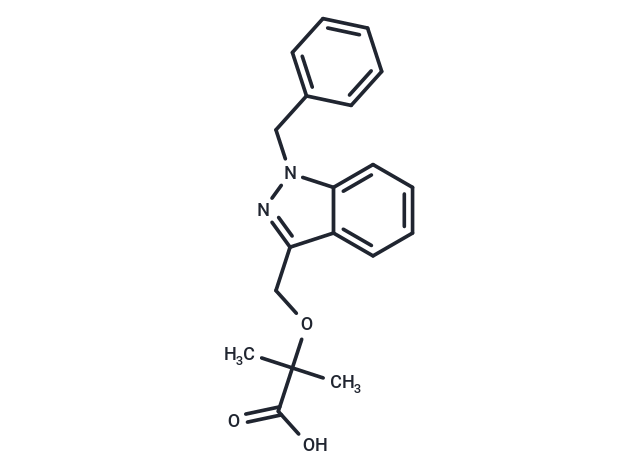Shopping Cart
Remove All Your shopping cart is currently empty
Your shopping cart is currently empty
Bindarit is a selective inhibitor of monocyte chemoattractant proteins MCP-1/CCL2, MCP-3/CCL7 and MCP-2/CCL8 with anti-inflammatory effects. Bindarit specifically inhibits p65- and p65/p50-induced MCP-1 promoter activation and has no effect on other tested activated promoters.

| Pack Size | Price | USA Warehouse | Global Warehouse | Quantity |
|---|---|---|---|---|
| 1 mg | $32 | In Stock | In Stock | |
| 2 mg | $45 | In Stock | In Stock | |
| 5 mg | $73 | In Stock | In Stock | |
| 10 mg | $118 | In Stock | In Stock | |
| 25 mg | $198 | In Stock | In Stock | |
| 50 mg | $348 | In Stock | In Stock | |
| 100 mg | $547 | In Stock | In Stock | |
| 200 mg | $788 | In Stock | In Stock | |
| 1 mL x 10 mM (in DMSO) | $80 | In Stock | In Stock |
| Description | Bindarit is a selective inhibitor of monocyte chemoattractant proteins MCP-1/CCL2, MCP-3/CCL7 and MCP-2/CCL8 with anti-inflammatory effects. Bindarit specifically inhibits p65- and p65/p50-induced MCP-1 promoter activation and has no effect on other tested activated promoters. |
| Targets&IC50 | CCL2:403 µM, MCP-1:172 µM |
| In vitro | METHODS: Raw 264.7 cells were stimulated with LPS (1 μg/ml) at different time points (1, 2, 4, 8, and 24 h) with bindarit (AF2838) (300 μM, 1 h before treatment) to investigate the mechanism by which bindarit exerts its anti-inflammatory effects. RESULTS Bindarit pretreatment significantly reduced MCP-1 mRNA levels, and at the highest LPS-induced peak (4 h), MCP-2 and MCP-3 gene expressions were inhibited by 24% and 36%, respectively. [1] |
| In vivo | METHODS: Bindarit (AF2838) (200 μg/g) was used to treat the OVX mouse model to verify the expression of CCL2 and CCL7. RESULTS Bindarit attenuated the expression of CCL2 and CCL7 in the OVX mouse model. [2] |
| Synonyms | AF2838 |
| Molecular Weight | 324.37 |
| Formula | C19H20N2O3 |
| Cas No. | 130641-38-2 |
| Smiles | CC(C)(OCc1nn(Cc2ccccc2)c2ccccc12)C(O)=O |
| Relative Density. | 1.18g/cm3 |
| Storage | Powder: -20°C for 3 years | In solvent: -80°C for 1 year | Shipping with blue ice/Shipping at ambient temperature. | ||||||||||||||||||||||||||||||||||||||||
| Solubility Information | Ethanol: 25 mg/mL (77.07 mM), Sonication is recommended. DMSO: 45 mg/mL (138.73 mM), Sonication is recommended. H2O: < 1 mg/mL (insoluble or slightly soluble) | ||||||||||||||||||||||||||||||||||||||||
| In Vivo Formulation | 10% DMSO+40% PEG300+5% Tween 80+45% Saline: 2 mg/mL (6.17 mM), Sonication is recommended. Please add the solvents sequentially, clarifying the solution as much as possible before adding the next one. Dissolve by heating and/or sonication if necessary. Working solution is recommended to be prepared and used immediately. The formulation provided above is for reference purposes only. In vivo formulations may vary and should be modified based on specific experimental conditions. | ||||||||||||||||||||||||||||||||||||||||
Solution Preparation Table | |||||||||||||||||||||||||||||||||||||||||
Ethanol/DMSO
DMSO
| |||||||||||||||||||||||||||||||||||||||||
| Size | Quantity | Unit Price | Amount | Operation |
|---|

Copyright © 2015-2026 TargetMol Chemicals Inc. All Rights Reserved.